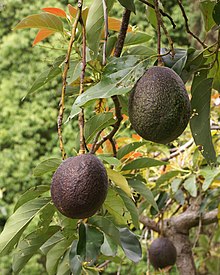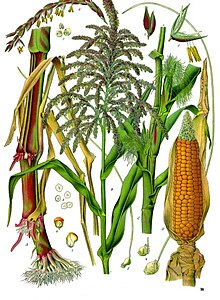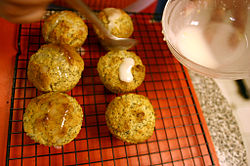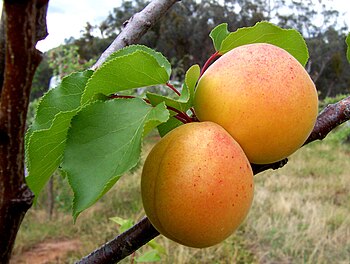F o o d
A portal dedicated to food and foodways
Introduction


Food is any substance consumed by an organism for nutritional support. Food is usually of plant, animal, or fungal origin and contains essential nutrients such as carbohydrates, fats, proteins, vitamins, or minerals. The substance is ingested by an organism and assimilated by the organism's cells to provide energy, maintain life, or stimulate growth. Different species of animals have different feeding behaviours that satisfy the needs of their metabolisms and have evolved to fill a specific ecological niche within specific geographical contexts.
Omnivorous humans are highly adaptable and have adapted to obtain food in many different ecosystems. Humans generally use cooking to prepare food for consumption. The majority of the food energy required is supplied by the industrial food industry, which produces food through intensive agriculture and distributes it through complex food processing and food distribution systems. This system of conventional agriculture relies heavily on fossil fuels, which means that the food and agricultural systems are one of the major contributors to climate change, accounting for as much as 37% of total greenhouse gas emissions. (Full article...)
Cooking, also known as cookery or professionally as the culinary arts, is the art, science and craft of using heat to make food more palatable, digestible, nutritious, or safe. Cooking techniques and ingredients vary widely, from grilling food over an open fire, to using electric stoves, to baking in various types of ovens, reflecting local conditions. Cooking is an aspect of all human societies and a cultural universal.
Preparing food with heat or fire is an activity unique to humans. Archeological evidence of cooking fires from at least 300,000 years ago exists, but some estimate that humans started cooking up to 2 million years ago.
The expansion of agriculture, commerce, trade, and transportation between civilizations in different regions offered cooks many new ingredients. New inventions and technologies, such as the invention of pottery for holding and boiling of water, expanded cooking techniques. Some modern cooks apply advanced scientific techniques to food preparation to further enhance the flavor of the dish served. (Full article...)
An apple is a round, edible fruit produced by an apple tree (Malus spp., among them the domestic or orchard apple; Malus domestica). Apple trees are cultivated worldwide and are the most widely grown species in the genus Malus. The tree originated in Central Asia, where its wild ancestor, Malus sieversii, is still found. Apples have been grown for thousands of years in Eurasia and were introduced to North America by European colonists. Apples have religious and mythological significance in many cultures, including Norse, Greek, and European Christian tradition.
Apples grown from seed tend to be very different from those of their parents, and the resultant fruit frequently lacks desired characteristics. For commercial purposes, including botanical evaluation, apple cultivars are propagated by clonal grafting onto rootstocks. Apple trees grown without rootstocks tend to be larger and much slower to fruit after planting. Rootstocks are used to control the speed of growth and the size of the resulting tree, allowing for easier harvesting. (Full article...)
Selected article –
The avocado, alligator pear or avocado pear (Persea americana) is a medium-sized, evergreen tree in the laurel family (Lauraceae). It is native to the Americas and was first domesticated in Mesoamerica more than 5,000 years ago. It was prized for its large and unusually oily fruit. The tree likely originated in the highlands bridging south-central Mexico and Guatemala. Avocado trees have a native growth range from Mexico to Costa Rica. Its fruit, sometimes also referred to as an alligator pear or avocado pear, is botanically a large berry containing a single large seed. Sequencing of its genome showed that the evolution of avocados was shaped by polyploidy events and that commercial varieties have an hybrid origin. Avocado trees are partly self-pollinating, and are often propagated through grafting to maintain consistent fruit output. Avocados are presently cultivated in the tropical and Mediterranean climates of many countries. Mexico is the world's leading producer of avocados as of 2020, supplying nearly 30% of the global harvest in that year.
The fruit of domestic varieties have smooth, buttery, golden-green flesh when ripe. Depending on the cultivar, avocados have green, brown, purplish, or black skin, and may be pear-shaped, egg-shaped, or spherical. For commercial purposes the fruits are picked while unripe and ripened after harvesting. The nutrient density and extremely high fat content of avocado flesh are useful to a variety of cuisines and are often eaten to enrich vegetarian diets. (Full article...)Selected cuisine -
Australian cuisine is the food and cooking practices of Australia and its inhabitants. Australia has absorbed culinary contributions and adaptations from various cultures around the world, including British, European, Asian and Middle Eastern.
Indigenous Australians have occupied Australia for some 65,000 years, during which they developed a unique hunter-gatherer diet, known as bush tucker, drawn from regional Australian plants and animals. Australia became a collection of British colonies from 1788 to 1900, during which time culinary tastes were strongly influenced by British and Irish migrants, with agricultural products such as beef cattle, sheep and wheat becoming staples in the local diet. The Australian gold rushes introduced more varied immigrants and cuisines, mainly Chinese, whilst post-war immigration programs led to a large-scale diversification of local food, mainly due to the influence of migrants from the Mediterranean, East Asia and South Asia. (Full article...)Selected ingredient –
Maize /meɪz/ (Zea mays), also known as corn in North American English, is a tall stout grass that produces cereal grain. It was domesticated by indigenous peoples in southern Mexico about 9,000 years ago from wild teosinte. Native Americans planted it alongside beans and squashes in the Three Sisters polyculture. The leafy stalk of the plant gives rise to male inflorescences or tassels which produce pollen, and female inflorescences called ears. The ears yield grain, known as kernels or seeds. In modern commercial varieties, these are usually yellow or white; other varieties can be of many colors.
Maize relies on humans for its propagation. Since the Columbian exchange, it has become a staple food in many parts of the world, with the total production of maize surpassing that of wheat and rice. Much maize is used for animal feed, whether as grain or as the whole plant, which can either be baled or made into the more palatable silage. Sugar-rich varieties called sweet corn are grown for human consumption, while field corn varieties are used for animal feed, for uses such as cornmeal or masa, corn starch, corn syrup, pressing into corn oil, alcoholic beverages like bourbon whiskey, and as chemical feedstocks including ethanol and other biofuels. (Full article...)
Selected recipe –
The muffins pictured are a variation on the classic lemon poppy seed muffin. Made with real lemon zest and covered with a lemon-flavored confectioners glaze, they are an ideal companion for a Sunday brunch.
Boletus edulis (English: cep, penny bun, porcino or porcini) is a basidiomycete fungus, and the type species of the genus Boletus. Widely distributed in the Northern Hemisphere across Europe, Asia, and North America, it does not occur naturally in the Southern Hemisphere, although it has been introduced to southern Africa, Australia, New Zealand, and Brazil. Several closely related European mushrooms formerly thought to be varieties or forms of B. edulis have been shown using molecular phylogenetic analysis to be distinct species, and others previously classed as separate species are conspecific with this species. The western North American species commonly known as the California king bolete (Boletus edulis var. grandedulis) is a large, darker-coloured variant first formally identified in 2007.
The fungus grows in deciduous and coniferous forests and tree plantations, forming symbiotic ectomycorrhizal associations with living trees by enveloping the tree's underground roots with sheaths of fungal tissue. The fungus produces spore-bearing fruit bodies above ground in summer and autumn. The fruit body has a large brown cap which on occasion can reach 30 cm (12 in), rarely 40 cm (16 in) in diameter and 3 kg (6 lb 10 oz) in weight. Like other boletes, it has tubes extending downward from the underside of the cap, rather than gills; spores escape at maturity through the tube openings, or pores. The pore surface of the B. edulis fruit body is whitish when young, but ages to a greenish-yellow. The stout stipe, or stem, is white or yellowish in colour, up to 20 cm (8 in), rarely 30 cm (12 in) tall and 10 cm (4 in) thick, and partially covered with a raised network pattern, or reticulations. (Full article...)Selected image –
Selected biography –
B. April 24, 1914 – d. September 5, 2001
"Way back when I first started as a safety engineer, I took myself pretty seriously, and I found I was putting my audiences to sleep. So having lived all my life among the Cajuns of Louisiana, and having a good memory for the patois and the type of humor Cajuns go for, I started interspersing my talks on safety with Cajun humor."
Justin Wilson
Justin Elmer Wilson (April 24, 1914 – September 5, 2001) was a Southern American chef and humorist known for his brand of Cajun-inspired cuisine, humor and storytelling. (Full article...)
Did you know (auto-generated) –

- ... that John Bunker was inspired to propagate old apple tree varieties after encountering Black Oxford apples while managing the food co-op in Belfast, Maine?
- ... that not all military rations are food?
- ... that the Indianapolis Community Food Access Coalition was created to resolve food deserts in the city of Indianapolis?
- ... that the Creamoata Mill, which once produced a now-nonexistent breakfast food, was listed as Gore's only "place of outstanding historical and cultural influence"?
- ... that in 1776 Abraham Hunt entertained Hessian mercenaries with food and drink to render them incapable for duty the night before George Washington defeated them at Trenton?
- ... that strawberry pie is one of the "red foods" traditionally served at Juneteenth celebrations?
More did you know –
Related portals
Food topics
The following are topics relating to food
Categories
Food list articles
- See also: Lists of foods and Category:Lists of drinks
The following are some Food list articles on Wikipedia:

- American cheeses
- Appellation d'Origine Contrôlée cheeses
- Apple cultivars
- Bacon dishes
- Bacon substitutes
- Basil cultivars
- Breads
- Breakfast beverages
- Breakfast cereals
- Breakfast foods
- British cheeses
- Cakes
- Candies
- Cheeses
- Cheese soups
- Christmas dishes (list)
- Cocktails
- Cookies
- Dishes using coconut milk
- Diets
- Doughnut varieties
- Egg dishes
- Fermented soy products
- Food additives
- Food additives (Codex Alimentarius)
- Foods named after people
- French cheeses
- French dishes
- Fried dough foods
- Fruits
- List of hamburgers
- Herbs and spices
- Hors d'oeuvre
- Indian dishes
- Indian snack foods
- Indonesian dishes
- Italian dishes
- Japanese snacks
- Japanese dishes
- Jewish dishes
- Kebabs
- Korean beverages
- Mango cultivars
- Moroccan dishes
- Pasta
- Pastries
- Philippine snack food
- Pies, tarts and flans
- Poppy seed pastries and dishes
- Potato dishes
- Puddings
- Raw fish dishes
- Rice dishes
- Rolled foods
- Sauces
- Seafood
- Seeds
- Sandwiches
- Snack foods
- Soft drinks by country
- Soul foods and dishes
- Soups
- Stews
- Street foods
- Tapas
- Turkish dishes
- Twice-baked foods
- Vegetable oils
- Vegetables
- Vodkas
Things you can do
Related WikiProjects
| Parent project: WikiProject Food and Drink | |
| Child projects: | Task forces: (All inactive) |
|
|
| Related projects: | |
New articles
Rules | Match log | Results page (for watching) | Last updated: 2024-07-26 19:17 (UTC)
Note: The list display can now be customized by each user. See List display personalization for details.
- Café Hagen (edit | talk | history | links | watch | logs | tools) by Another Believer (talk · contribs · new pages (102)) started on 2024-07-23, score: 10
- Mannion v. Coors Brewing Co. (edit | talk | history | links | watch | logs | tools) by Daniel Case (talk · contribs · new pages (7)) started on 2024-07-25, score: 10
- Meldon Reservoir (edit | talk | history | links | watch | logs | tools) by Owain.davies (talk · contribs · new pages (1)) started on 2024-07-24, score: 10
- Pendennis Club (cocktail) (edit | talk | history | links | watch | logs | tools) by Nbarth (talk · contribs · new pages (3)) started on 2024-07-24, score: 10
- Lewis Orford (footballer) (edit | talk | history | links | watch | logs | tools) by 86.18.110.36 (talk · contribs · new pages (1)) started on 2024-07-24, score: 10
- Hags (restaurant) (edit | talk | history | links | watch | logs | tools) by MainlyTwelve (talk · contribs · new pages (8)) started on 2024-07-23, score: 10
- Angelito Esguerra (edit | talk | history | links | watch | logs | tools) by YssaLang (talk · contribs · new pages (34)) started on 2024-07-23, score: 10
- Moon Si-woo (edit | talk | history | links | watch | logs | tools) by TracyFleuryFan (talk · contribs · new pages (3)) started on 2024-07-23, score: 10
- Kim Ji-yoon (curler) (edit | talk | history | links | watch | logs | tools) by TracyFleuryFan (talk · contribs · new pages (3)) started on 2024-07-22, score: 10
- Tavern Talk (edit | talk | history | links | watch | logs | tools) by CoffeeTalkBarista (talk · contribs · new pages (2)) started on 2024-07-21, score: 20
- Ossetian cheese (edit | talk | history | links | watch | logs | tools) by Mazdayasnah (talk · contribs · new pages (1)) started on 2024-07-16, score: 10
- Martha Brotherton (edit | talk | history | links | watch | logs | tools) by Throughthemind (talk · contribs · new pages (14)) started on 2024-07-22, score: 10
- Bellwether Bar (edit | talk | history | links | watch | logs | tools) by Another Believer (talk · contribs · new pages (102)) started on 2024-07-21, score: 10
- Candyland (Brooke Candy album) (edit | talk | history | links | watch | logs | tools) by BiggestBidder (talk · contribs · new pages (1)) started on 2024-07-21, score: 10
- Dovyalis affra (edit | talk | history | links | watch | logs | tools) by Sminthopsis84 (talk · contribs · new pages (2)) started on 2024-07-20, score: 10
- Peely (edit | talk | history | links | watch | logs | tools) by Soulbust (talk · contribs · new pages (10)) started on 2024-07-20, score: 10
- Omnivore (TV series) (edit | talk | history | links | watch | logs | tools) by Crcolas (talk · contribs · new pages (10)) started on 2024-07-20, score: 20
- Solveig Strand (edit | talk | history | links | watch | logs | tools) by Geschichte (talk · contribs · new pages (20)) started on 2024-07-20, score: 10
- Elm Coffee Roasters (edit | talk | history | links | watch | logs | tools) by Another Believer (talk · contribs · new pages (102)) started on 2024-07-20, score: 10
- Moore Coffee (edit | talk | history | links | watch | logs | tools) by Another Believer (talk · contribs · new pages (102)) started on 2024-07-19, score: 10
- Frigo (ice cream) (edit | talk | history | links | watch | logs | tools) by YuSkinsColombianos (talk · contribs · new pages (3)) started on 2024-07-12, score: 10
- Gene Camarena (edit | talk | history | links | watch | logs | tools) by Bsoyka (talk · contribs · new pages (24)) started on 2024-07-19, score: 10
- Rice paddle (edit | talk | history | links | watch | logs | tools) by MicrobiologyMarcus (talk · contribs · new pages (4)) started on 2024-07-19, score: 10
- Siŭijŏnsŏ (edit | talk | history | links | watch | logs | tools) by Ahecht (talk · contribs · new pages (70)) started on 2024-07-19, score: 10
- Franz Bock (SA-Obergruppenführer) (edit | talk | history | links | watch | logs | tools) by Historybuff0105 (talk · contribs · new pages (8)) started on 2024-07-18, score: 10
- List of grass jelly plants (edit | talk | history | links | watch | logs | tools) by Awkwafaba (talk · contribs · new pages (96)) started on 2024-07-11, score: 10
- Tennessee Alcoholic Beverage Commission (edit | talk | history | links | watch | logs | tools) by Dmoore5556 (talk · contribs · new pages (9)) started on 2024-07-18, score: 10
- Mississippi Office of Alcoholic Beverage Control (edit | talk | history | links | watch | logs | tools) by Dmoore5556 (talk · contribs · new pages (9)) started on 2024-07-17, score: 10
- Michael Mosley (edit | talk | history | links | watch | logs | tools) by SafariScribe (talk · contribs · new pages (191)) started on 2024-07-17, score: 10
- La Grande Maison Paris (edit | talk | history | links | watch | logs | tools) by Yut3117 (talk · contribs · new pages (1)) started on 2024-07-17, score: 20
- Mattoni 1873 (edit | talk | history | links | watch | logs | tools) by Revirvlkodlaku (talk · contribs · new pages (2)) started on 2024-07-17, score: 10
- Honeydew honey (edit | talk | history | links | watch | logs | tools) by Fgnievinski (talk · contribs · new pages (14)) started on 2024-07-17, score: 10
- Más+ (edit | talk | history | links | watch | logs | tools) by Bennett1203 (talk · contribs · new pages (4)) started on 2024-07-16, score: 30
- Los Gorditos (edit | talk | history | links | watch | logs | tools) by Another Believer (talk · contribs · new pages (102)) started on 2024-07-16, score: 10
- Ahluwalia (caste) (edit | talk | history | links | watch | logs | tools) by Liz (talk · contribs · new pages (20)) started on 2024-07-16, score: 10
- Costello's (edit | talk | history | links | watch | logs | tools) by Voorts (talk · contribs · new pages (22)) started on 2024-07-12, score: 10
- Klaxon (song) (edit | talk | history | links | watch | logs | tools) by Paper9oll (talk · contribs · new pages (21)) started on 2024-07-08, score: 10
- White sauce (Virginia) (edit | talk | history | links | watch | logs | tools) by Bookworm-ce (talk · contribs · new pages (10)) started on 2024-07-16, score: 30
- Barista Coffee (Taiwan) (edit | talk | history | links | watch | logs | tools) by Heeheemalu (talk · contribs · new pages (7)) started on 2024-07-16, score: 30
- Cama Café (edit | talk | history | links | watch | logs | tools) by Heeheemalu (talk · contribs · new pages (7)) started on 2024-07-16, score: 30
- Dante Coffee (edit | talk | history | links | watch | logs | tools) by Heeheemalu (talk · contribs · new pages (7)) started on 2024-07-16, score: 30
- Nielsen's Frozen Custard (edit | talk | history | links | watch | logs | tools) by DarkNight0917 (talk · contribs · new pages (4)) started on 2024-07-16, score: 20
- Milo's Tea Company (edit | talk | history | links | watch | logs | tools) by DarkNight0917 (talk · contribs · new pages (4)) started on 2024-07-15, score: 20
- Scooter's Coffee (edit | talk | history | links | watch | logs | tools) by TCMemoire (talk · contribs · new pages (39)) started on 2024-07-15, score: 20
- Top Coffee bombing (edit | talk | history | links | watch | logs | tools) by QalasQalas (talk · contribs · new pages (15)) started on 2024-07-15, score: 10
- Top Cafe bombing (edit | talk | history | links | watch | logs | tools) by QalasQalas (talk · contribs · new pages (15)) started on 2024-07-15, score: 10
- Fairlie Bakehouse (edit | talk | history | links | watch | logs | tools) by Cloventt (talk · contribs · new pages (1)) started on 2024-07-15, score: 20
- Agricultural finance (edit | talk | history | links | watch | logs | tools) by Stebanoid (talk · contribs · new pages (1)) started on 2024-07-14, score: 10
- The Bubble Room (edit | talk | history | links | watch | logs | tools) by MiamiMogul (talk · contribs · new pages (40)) started on 2024-07-14, score: 10
- Taoyuan Taiwan Beer Leopards all-time roster (edit | talk | history | links | watch | logs | tools) by Tywu99 (talk · contribs · new pages (9)) started on 2024-07-14, score: 10
- Health effects of ultra-processed foods (edit | talk | history | links | watch | logs | tools) by Henry Trevithick (talk · contribs · new pages (1)) started on 2024-07-13, score: 10
- Tsang Ying Tou (edit | talk | history | links | watch | logs | tools) by Heeheemalu (talk · contribs · new pages (7)) started on 2024-07-14, score: 10
- Tastien (edit | talk | history | links | watch | logs | tools) by Thriley (talk · contribs · new pages (37)) started on 2024-07-13, score: 10
- Honolulu Fish Auction (edit | talk | history | links | watch | logs | tools) by Netherzone (talk · contribs · new pages (3)) started on 2024-07-13, score: 10
- Papaya milk (edit | talk | history | links | watch | logs | tools) by Heeheemalu (talk · contribs · new pages (7)) started on 2024-07-13, score: 20
- Tavern Law (edit | talk | history | links | watch | logs | tools) by Another Believer (talk · contribs · new pages (102)) started on 2024-07-12, score: 10
- Casinetto (edit | talk | history | links | watch | logs | tools) by Hen Hao Li (talk · contribs · new pages (1)) started on 2024-07-12, score: 20
- Aloo chap (edit | talk | history | links | watch | logs | tools) by Hemant Dabral (talk · contribs · new pages (58)) started on 2024-07-12, score: 20
- Konradas cafe (edit | talk | history | links | watch | logs | tools) by KrivisKrivaitis (talk · contribs · new pages (6)) started on 2024-07-10, score: 10
Associated Wikimedia
The following Wikimedia Foundation sister projects provide more on this subject:
-
Commons
Free media repository -
Wikibooks
Free textbooks and manuals -
Wikidata
Free knowledge base -
Wikinews
Free-content news -
Wikiquote
Collection of quotations -
Wikisource
Free-content library -
Wikiversity
Free learning tools -
Wiktionary
Dictionary and thesaurus

















































